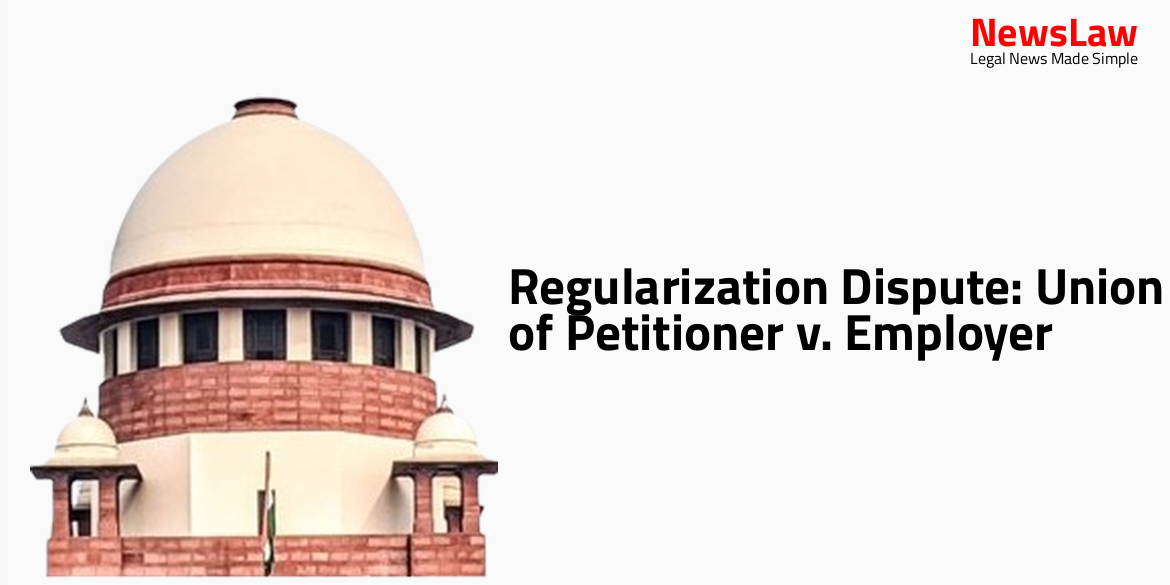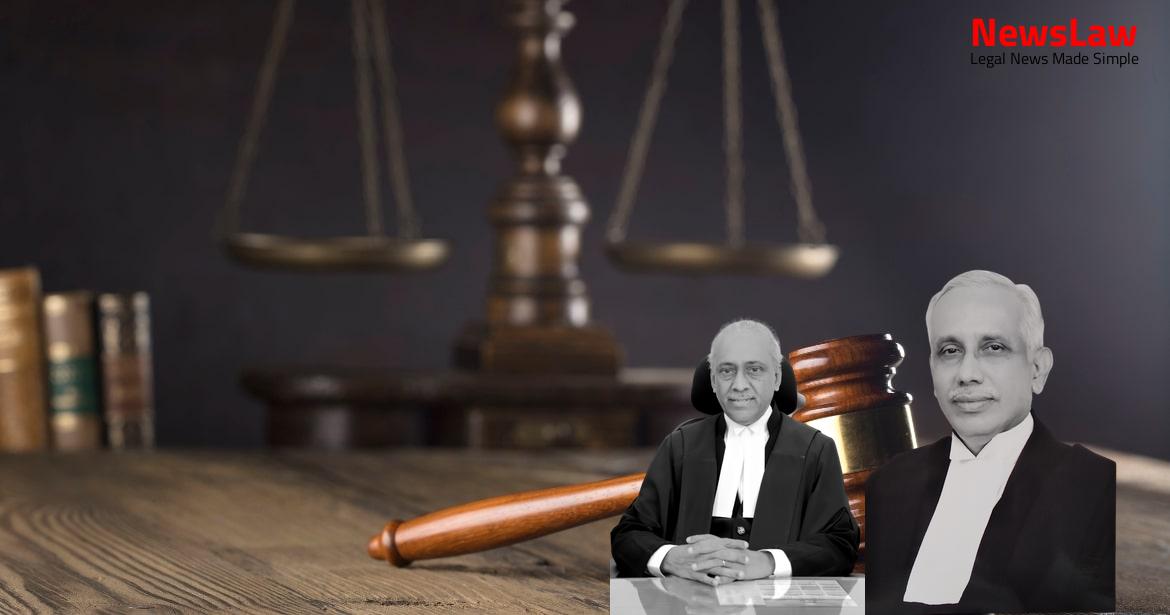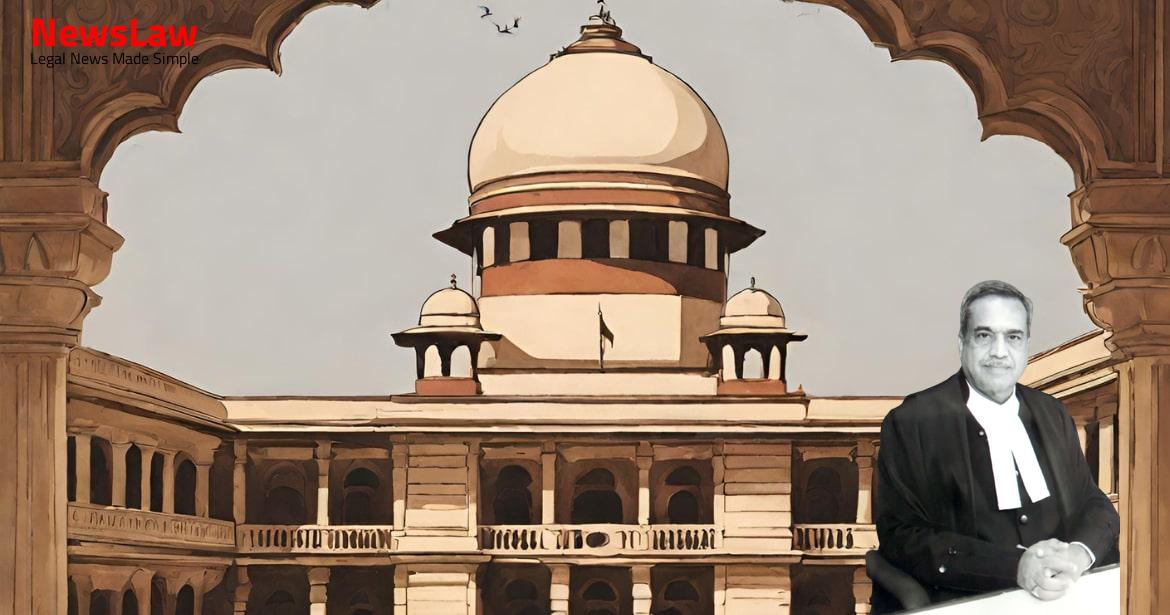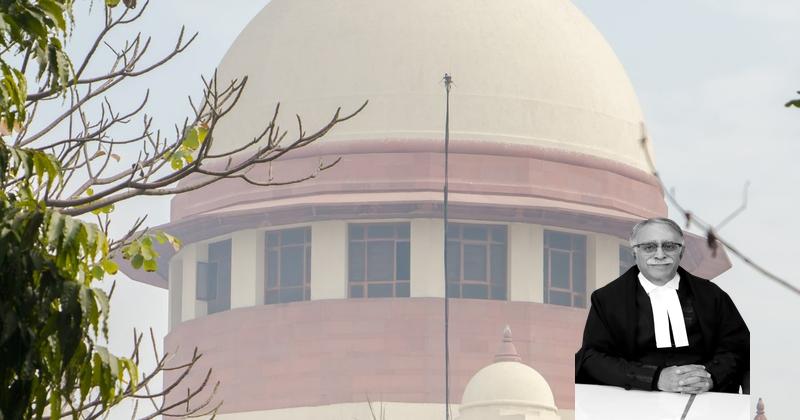In a significant case heard by the Delhi High Court, the dispute between the Union of Petitioner and their Employer regarding regularization was addressed. The court’s ruling has far-reaching implications in the realm of labor relations and employee rights. Stay informed on the latest legal developments by following our updates. #LegalCase #DelhiHighCourt #Judgment #Regularization
Facts
- Union of the petitioner served a legal demand notice dated 5 March, 2005.
- The respondent did not reply to the legal demand notice.
- The issues before the Industrial Tribunal were related to the relationship between employer and employee, and terms of reference.
- A statement of claim was filed by the Union on 7 April, 2005.
- The petitioner’s services were not regularized despite reinstatement.
- An industrial dispute was raised by the petitioner and referred to the Labour Court.
- The respondent did not file a written statement despite reminders.
- After failed conciliation, the industrial dispute was referred for adjudication on non-regularization of services.
- The Labour Court passed an award on 3 January, 2002, stating that the termination of the petitioner was illegal and ordered reinstatement with back wages from 17 July, 1996.
- However, the Industrial Tribunal later ruled on the same day that there was a break in service for the petitioner as a daily wager muster roll employee before reinstatement in 1996.
- The Industrial Tribunal’s decision was based on the break in service and concluded that the period before reinstatement couldn’t be considered for regularisation.
Issue
- Limited question for adjudication is whether the impugned award suffers from any illegality
- Focus is on determining if there is any legal flaw in the award
- Not considering the merits of the award, but rather its legality
Arguments
- The respondent argues that the petitioner was engaged as a Beldar on daily wages muster roll for specific work and not in continuous employment.
- It is contended that the petitioner abandoned his employment, leading to his termination.
- The respondent refutes the petitioner’s claim of illegal termination based on the nature of the petitioner’s engagement and work status.
- The petitioner argues that there has been hostile discrimination compared to similarly placed employees who were regularized from 1 April, 1990.
- The petitioner points out that he has not worked continuously for the respondent and should not be equated with employees who underwent the official selection process.
- Management has a policy for regularizing daily wage muster roll employees based on post availability.
- The petitioner insists on being regularized from the initial date of appointment or from 1 April, 1990 per the respondent’s policy.
- The petitioner worked from 8 May, 1982, to 9 January, 1993, and later sought fresh employment in November 1993.
- The petitioner challenges the adjudicator’s decision to count continuous service from 17 July, 1996, instead of the initial appointment date or 1 April, 1990.
- The petitioner’s counsel argues that the adjudicator’s award violates constitutional articles and should be set aside.
- It is emphasized that the reinstatement with 50% back wages implies employment from the initial date of appointment, i.e., 8 May, 1982.
- The respondent’s counsel denies the petitioner’s entitlement to be treated as a regular and permanent employee from the initial joining date.
Analysis
- The court emphasized the importance of serving a notice in writing to the Petitioner by the management of the respondent.
- Temporary employees and ad hoc employees do not acquire any right to claim regularisation or permanent status upon the expiry of their term.
- Appointment must be in accordance with relevant rules and through proper competition among qualified persons to confer any right on the appointee.
- Failure of the respondent management to provide evidence of informing the petitioner to resume duties was noted.
- The court highlighted that interim directions to continue employment may hold up regular selection procedures or burden the State with unnecessary payments.
- Judicial interference should not facilitate bypassing of constitutional and statutory mandates in employment matters involving the State or its instrumentalities.
- The court upheld that the petitioner’s services could not be regularised due to a break in service.
- No presumption of job abandonment by the Petitioner should be made.
- Continuation of temporary employees or casual wage workers beyond their appointment term does not automatically entitle them to absorption or permanency if the original appointment process was not followed.
- The petitioner provided documentary evidence of his employment, showing periods of service, removal, and re-engagement.
- Absence of a charge sheet, domestic inquiry, and insufficient evidence for termination were cited as reasons for the petitioner’s reinstatement with full back wages for continuous service.
- No workman can be retrenched by an employer until certain conditions are met.
- Conditions include giving one month’s notice or wages in lieu of notice, paying compensation equivalent to fifteen days’ average pay for every completed year of service, and serving notice to the appropriate Government.
- The provisions of Section 25-F of the Industrial Disputes Act, 1947 outline these conditions.
- The Act aims to protect the rights of workmen and ensure fair treatment during retrenchment.
- Adherence to the rule of equality in public employment is a basic feature of the Constitution.
- The rule of law is the core of the Constitution.
- A Court would violate Article 14 by ordering to overlook the need to comply with the requirements of Article 14 read with Article 16 of the Constitution.
- The judgment in Uma Devi case clarifies not to interfere if the agreement between employer and employee is in line with the law.
- In Bharatiya Kamgar Karmachari Mahasangh v. M/s. Jet Airways Ltd., the Supreme Court held that an employee with over 240 days of continuous service is entitled to permanent status.
- No contract or settlement can abridge the right to permanent status for an employee who has worked for 240 days in an establishment.
- The Act prohibits agreements where employee rights are waived, overriding standing orders.
- The Petitioner in this case has rendered continuous service exceeding 240 days with the Respondent, hence should be regularized as a permanent employee.
- The settled position of law on regularization of workers has been clarified by the Supreme Court in Secretary, State of Karnataka & Ors. v. Umadevi (3) & Ors. (2006 4 SCC 1).
- For contractual appointments, the appointment ends at the contract’s end; for engagements on daily wages or casual basis, it ends when discontinued.
- The question of whether the petitioner workman is entitled to regularization based on services rendered in the respondent department cannot be re-adjudicated by the Court.
- The findings of the Industrial Adjudicator concerning the entitlement of the workman to regularization are considered final.
- The impugned award dated 3 January, 2002, passed by the Industrial Adjudicator, is upheld by the Court.
Decision
- The instant writ petition has been dismissed by the court.
- Any pending applications related to the petition are also dismissed.
- The decision is final and binding.
Case Title: MOHKAM SINGH Vs. DELHI JAL BOARD (2024:DHC:4705)
Case Number: W.P.(C)-12253/2009



